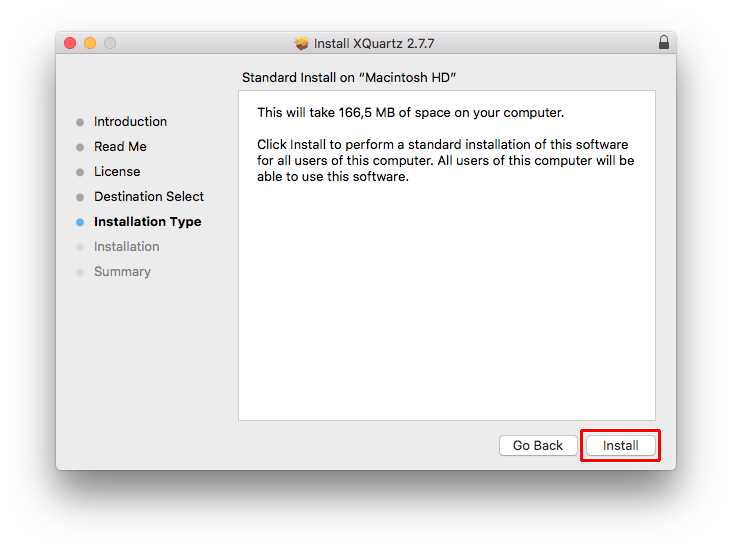

- You need to install xquartz 2.7.7 or higher first. how to#
- You need to install xquartz 2.7.7 or higher first. full#
- You need to install xquartz 2.7.7 or higher first. software#
6.1.2 Statistical inference on a sample.5.4 Confidence Intervals for the Sample Mean.
You need to install xquartz 2.7.7 or higher first. software#
You need to install xquartz 2.7.7 or higher first. how to#
2.1 How to download and install R and RStudio.If you attempt to install some binary package (e.g., through an installer), you're bound to mess up things. Something similar goes if you like to use, e.g., Anaconda Python. Or, if you using setup.py, with the appropriate Python executable. Make aliases, if necessary, for /usr/local/bin/python2.7 and corresponding pip.if you want to use the latest Python version(s), (re)install Python 2 (and 3 just try it out) with Homebrew.The following depends on if you want to use Homebrew: make sure /usr/local/bin is included in PATH, but don't necessary set it at the front of PATH.Alternatively, I could run /usr/local/bin/pythonx.y /usr/local/bin/pip and the correct pip is used.) (The tricky part with multiple versions is pip: I've made multiple copies of pip, each named differently, each with a different hash-bang as the first line. And I still have my system Python at /usr/bin/python for system scripts. In fact, this way I'm running Python 2.7, 3.4 and 3.5 all in /usr/local/bin, all with aliases.
You need to install xquartz 2.7.7 or higher first. full#
Either use the full path, /usr/local/bin/python, or set an alias (which is shorter to type). The catch with this is that /usr/bin/python is likely to be found earlier on your PATH than /usr/local/bin/python. No need for PYTHONPATH, everything works if I make sure I use /usr/local/bin/python. My default PATH already includes /usr/local/bin, and I use /usr/local/bin/pip to install packages for that particular Python. You wouldn't have to need PYTHONPATH if you install the necessary packages for the particular Python you're using (using, for example, the complementary pip) and you can amend PATH to include that Python executable, if it's not already on PATH.įor example, I use Homebrew Python.


The first one says to clean my path but I have no idea how to do that and the second has no answers.Īny help would be greatly appreciated since I don't want to use my computer until I can make sure everything is fixed!ĮDIT: Will using export $PATH = /usr/local/bin fix my issue? I got that from this link: Īs per my second comment: your PATH and PYTHONPATH depend on what you are using. Repairing mysterious Python config scripts outside of the system I did my research and here are the links I found:

I got scared that I had messed something up because of two things first the message relating to config scripts and then this one : In particular, Pythons installed to /Library can interfere Homebrew only supports building against the System-provided Python or aīrewed Python. Warning: Python is installed at /Library/Frameworks/amework Warning: Your XQuartz (2.7.7) is outdated Library/Frameworks/amework/Versions/2.7/bin/python2.7-config Library/Frameworks/amework/Versions/2.7/bin/python2-config Library/Frameworks/amework/Versions/2.7/bin/python-config Homebrew if the config script overrides a system or Homebrew provided Having additional scripts in your path can confuse software installed via Software packages are installed, and what additional flags to use when configure scripts often look for *-config scripts to determine if Warning: "config" scripts exist outside your system or Homebrew directories. Then I got scared with a homebrew warning here it is: What is important is that when doing it I changed my $PYTHONPATH to this:Įxport PYTHONPATH=$PYTHONPATH:/usr/local/bin/./././Library/Frameworks/amework/Versions/2.7/lib/python2.7/site-packages So I was following a tutorial to help me learn Django. I need some major help and am a bit scared since I do not want to mess up my computer!I am on a Macbook Air running OSX 10.10.5.


 0 kommentar(er)
0 kommentar(er)
